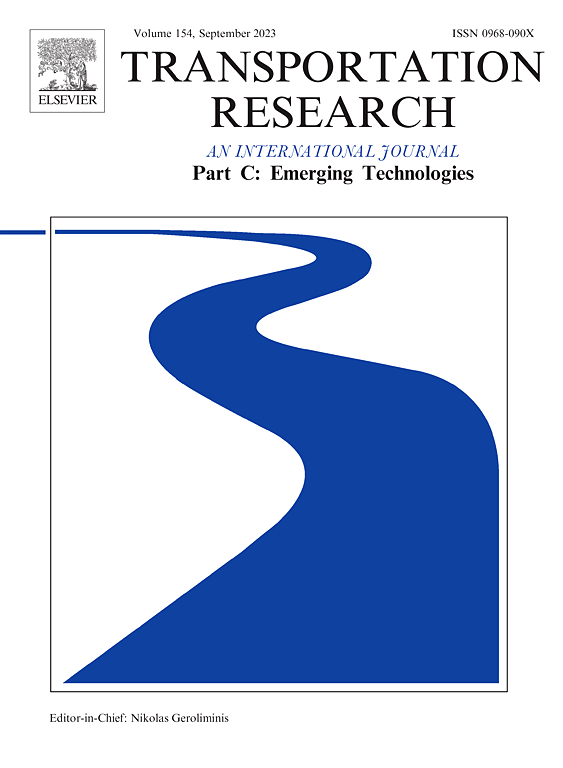On solving the suburban commuting problem in megacities: Integrating ridesharing with urban rail transit
IF 7.6
1区 工程技术
Q1 TRANSPORTATION SCIENCE & TECHNOLOGY
Transportation Research Part C-Emerging Technologies
Pub Date : 2025-04-18
DOI:10.1016/j.trc.2025.105120
引用次数: 0
Abstract
The increasing spatial separation between workplaces and residences, coupled with the continued rise in motor vehicle ownership, has significantly strained urban traffic during rush hours. Suburban commuters, in particular, experience prolonged travel times. To enhance suburban commuting efficiency and alleviate congestion, this paper introduces a novel approach to address the Suburban Commuting Problem (SCP) in megacities. The proposed solution integrates ridesharing with urban rail transit (URT) systems. By promoting ridesharing in suburban areas, commuters can broaden their options for URT stations, no longer restricted to the nearest but often overcrowded end stations. This approach enhances the accessibility of URT and helps alleviate queuing congestion at end stations. Consequently, this approach shortens travel times for suburban commuters. We formulate the SCP as an arc-flow mixed-integer linear programming model, as well as a set-partitioning formulation. We introduce a tailored branch-and-price (BP) algorithm based on the set-partitioning approach to accurately solve the SCP. To expedite the solution process for the pricing sub-problem, we devise a tailored label-setting algorithm incorporating a bi-directional search strategy. Finally, we evaluate our model and algorithm’s performance through extensive computational experiments and provide valuable managerial insights. The case results based on part of road network in Beijing indicate that the proposed optimized solution for the integrated commuting mode can reduce vehicle commuting distance by 34.65%, thereby mitigating traffic congestion and reducing pollutant emissions.
解决特大城市郊区通勤问题:拼车与城市轨道交通的融合
工作场所和住宅之间的空间距离越来越远,加上机动车拥有量的持续增加,在高峰时段严重紧张了城市交通。尤其是郊区通勤者,他们的出行时间更长。为了提高城郊通勤效率,缓解城市交通拥堵,本文提出了一种解决特大城市城郊通勤问题的新方法。提出的解决方案将拼车与城市轨道交通(URT)系统相结合。通过在郊区推广拼车,通勤者可以扩大他们对轨道交通车站的选择,不再局限于最近但往往人满为患的终点站。这种方法提高了轨道交通的可达性,并有助于缓解终端站的排队拥堵。因此,这种方法缩短了郊区通勤者的出行时间。我们将SCP表述为一个弧流混合整数线性规划模型,以及一个集划分公式。我们引入了一种基于集划分方法的定制分支价格(BP)算法来精确求解SCP问题。为了加快定价子问题的求解过程,我们设计了一种包含双向搜索策略的定制标签设置算法。最后,我们通过大量的计算实验来评估我们的模型和算法的性能,并提供有价值的管理见解。基于北京市部分路网的案例结果表明,提出的综合通勤模式优化方案可将车辆通勤距离缩短34.65%,从而缓解交通拥堵,减少污染物排放。
本文章由计算机程序翻译,如有差异,请以英文原文为准。
求助全文
约1分钟内获得全文
求助全文
来源期刊
CiteScore
15.80
自引率
12.00%
发文量
332
审稿时长
64 days
期刊介绍:
Transportation Research: Part C (TR_C) is dedicated to showcasing high-quality, scholarly research that delves into the development, applications, and implications of transportation systems and emerging technologies. Our focus lies not solely on individual technologies, but rather on their broader implications for the planning, design, operation, control, maintenance, and rehabilitation of transportation systems, services, and components. In essence, the intellectual core of the journal revolves around the transportation aspect rather than the technology itself. We actively encourage the integration of quantitative methods from diverse fields such as operations research, control systems, complex networks, computer science, and artificial intelligence. Join us in exploring the intersection of transportation systems and emerging technologies to drive innovation and progress in the field.

 求助内容:
求助内容: 应助结果提醒方式:
应助结果提醒方式:


